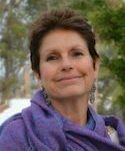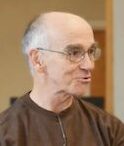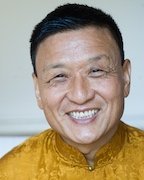November 16, 2021
A conversation with Adriana Dal Borgo, Peter Payne, Tenzin Wangyal Rinpoche, and host Alejandro Chaoul-Reich
Contemplative movement can include a number of practices such as yoga, dance, tai chi, tsa lung trul khor and yantra yoga. In their own unique ways, these practices integrate self-awareness, rhythm, sound, movement, conscious breath, disciplined form, or free flowing choreography. Pulled into a harmony, or potent melody, the effects may include release of tensions and blockages in body and mind.
This Science & Spirituality panel discussion delves into the inner workings of contemplative dance and somatic healing practices. Adriana is intimately prepared to communicate her understanding of body as mandala. Peter’s life studies, practice, and research suggest that the sciences also are discovering the bridges between higher mind and body.
View on the Facebook page of Tenzin Wangyal Rinpoche to join the chat, or view here on this page.
This CyberSangha broadcast is part of “A Year of Body, Speech, and Mind,” a free 2021 online program of live teachings, practices, and science & spirituality dialogs. Learn more
About the Presenters
 Adriana Dal Borgo found her spiritual teacher after earning a degree in psychology specializing in psychotherapy. From Master Chögyal Namkhai Norbu’s dzogchen teachings she studied the Vajra Dance and later the Khaita Joyful Dances, both of which integrate meditation and movement. Appointed by her master to teach, she has shared the Vajra Dance and has coordinated related activities in centers of the International Dzogchen Community.
Adriana Dal Borgo found her spiritual teacher after earning a degree in psychology specializing in psychotherapy. From Master Chögyal Namkhai Norbu’s dzogchen teachings she studied the Vajra Dance and later the Khaita Joyful Dances, both of which integrate meditation and movement. Appointed by her master to teach, she has shared the Vajra Dance and has coordinated related activities in centers of the International Dzogchen Community.
For many years, Adriana has coordinated the Khaita Joyful Dances and trained new teachers in this field of study. She has overseen several publications and audio and video recordings that go more deeply into the different aspects of these dances. Collaborating with Museum of Asian Art and Culture (MACO) in Arcidosso, Italy, Adriana has curated the section on Vajra Dance and Khaita Joyful Dances. Adriana has led many courses and trained new teachers around the world, helping students to discover the joy and profoundness of the Dance. She currently directs Khaita Dance courses and events, with performances and workshops in various countries.
 Peter Payne began a lifelong study and practice of somatics early in life. Born in London, Peter grew up in Switzerland, London, and the United States. After beginning Judo training at age 11, his interest in the martial arts grew to include karate, aikido, taijiquan, and most recently xingyiquan. At Harvard, Peter’s interest in physics and psychology led him to the human potential movement in its early days.
Peter Payne began a lifelong study and practice of somatics early in life. Born in London, Peter grew up in Switzerland, London, and the United States. After beginning Judo training at age 11, his interest in the martial arts grew to include karate, aikido, taijiquan, and most recently xingyiquan. At Harvard, Peter’s interest in physics and psychology led him to the human potential movement in its early days.
After college Peter began a lifelong study and practice of somatics. In the late ’60s he studied yoga with Rammurti Mishra, lived at one of R.D. Laing’s experimental communities, and learned massage and several forms of bodywork. He is qualified as a teacher of the Alexander Technique of postural re-education and is certified as a practitioner of Somatic Experiencing®, a form of trauma therapy. At Dartmouth College, New Hampshire, Peter conducted research into somatic practices and later published the results of several clinical trials and theoretical papers on the neuroscience behind somatic practices. See Peter’s recommended reading
 Geshe Tenzin Wangyal Rinpoche was born in India in 1961, following his parents’ journey from Tibet to India in 1959. At age 11 he began formal studies as a monk at Menri Monastery near Dolanji, India, where he completed an 11-year course of traditional studies at the Bön Dialectic School. He was awarded his geshe degree in 1986. He now lives as a householder, and has been living and teaching in the West for more than 30 years. An accomplished scholar in all aspects of sutra, tantra and dzogchen, Rinpoche is an acclaimed author and a respected teacher of students worldwide. As the founder and spiritual director of Ligmincha International, he has established numerous centers and institutes of learning in the United States, Mexico, South America, Europe and India. Fluent in English, Rinpoche regularly offers online teachings in the form of live webcasts, online workshops and YouTube videos. He is renowned for his depth of wisdom; his clear, engaging teaching style; and his dedication to making the ancient Tibetan teachings highly accessible and relevant to the lives of Westerners.
Geshe Tenzin Wangyal Rinpoche was born in India in 1961, following his parents’ journey from Tibet to India in 1959. At age 11 he began formal studies as a monk at Menri Monastery near Dolanji, India, where he completed an 11-year course of traditional studies at the Bön Dialectic School. He was awarded his geshe degree in 1986. He now lives as a householder, and has been living and teaching in the West for more than 30 years. An accomplished scholar in all aspects of sutra, tantra and dzogchen, Rinpoche is an acclaimed author and a respected teacher of students worldwide. As the founder and spiritual director of Ligmincha International, he has established numerous centers and institutes of learning in the United States, Mexico, South America, Europe and India. Fluent in English, Rinpoche regularly offers online teachings in the form of live webcasts, online workshops and YouTube videos. He is renowned for his depth of wisdom; his clear, engaging teaching style; and his dedication to making the ancient Tibetan teachings highly accessible and relevant to the lives of Westerners.
More about Tenzin Wangyal Rinpoche
 Alejandro Chaoul-Reich, Ph.D. (host) has studied in the Tibetan traditions since 1989, and for nearly 30 years in the Bön Tradition with Yongdzin Tenzin Namdak Rinpoche, His Holiness Lungtok Tenpai Nyima Rinpoche, and Tenzin Wangyal Rinpoche. He holds a Ph.D. in Tibetan religions from Rice University and is the director of the Mind Body Spirit Institute at the Jung Center of Houston. For the last 20 years he has been teaching and researching the benefits of Tibetan mind-body practices for people touched by cancer. Alejandro is a Contemplative Fellow at the Mind & Life Institute, and is the author of Chöd Practice in the Bön Tradition (Snow Lion, 2009), Tibetan Yoga for Health & Well-Being (Hay House, 2018), and the forthcoming Tibetan Yoga: Magical Movements of Body, Breath, and Mind (Wisdom Publications, November 23, 2021).
Alejandro Chaoul-Reich, Ph.D. (host) has studied in the Tibetan traditions since 1989, and for nearly 30 years in the Bön Tradition with Yongdzin Tenzin Namdak Rinpoche, His Holiness Lungtok Tenpai Nyima Rinpoche, and Tenzin Wangyal Rinpoche. He holds a Ph.D. in Tibetan religions from Rice University and is the director of the Mind Body Spirit Institute at the Jung Center of Houston. For the last 20 years he has been teaching and researching the benefits of Tibetan mind-body practices for people touched by cancer. Alejandro is a Contemplative Fellow at the Mind & Life Institute, and is the author of Chöd Practice in the Bön Tradition (Snow Lion, 2009), Tibetan Yoga for Health & Well-Being (Hay House, 2018), and the forthcoming Tibetan Yoga: Magical Movements of Body, Breath, and Mind (Wisdom Publications, November 23, 2021).
Photograph of vajra dancers courtesy of vajra dance community

I am a practitioner of Taoist Taichi and would like to hear the presenters´ opinion.
Hi, I’m trying to get on but it’s not working
Now I can’t get the sound to stay, unless I hold my mouse over it. Even then, it goes out. Refreshing the page doesn’t help.
Hi Kim, sorry you’re having difficulties. You might try using a different browser (for example, Chrome or Firefox), and if that doesn’t help, you could try clearing your cookies & cache and trying again. The recorded broadcast will be viewable here on this page afterward, in case you are able to view it later from the beginning.
Kim, I hope you were able to watch the live video. I heard from another person that the view of the video was blurry although it was clear here from the west coast. Here is the browser direct link you might want to try again: https://www.facebook.com/tenzinwangyalrinpoche/videos/176613301350352
Thank you for this wonderful panel, Rinpoche, Ale, Adriana and Peter! Inspiring and thought-provoking.